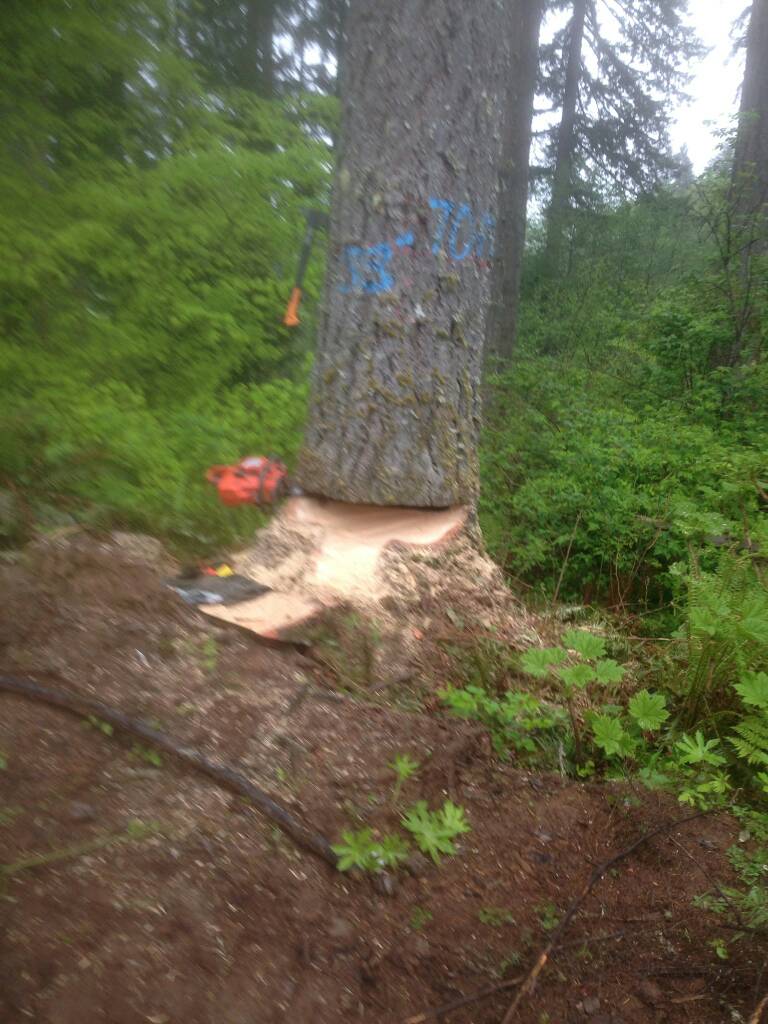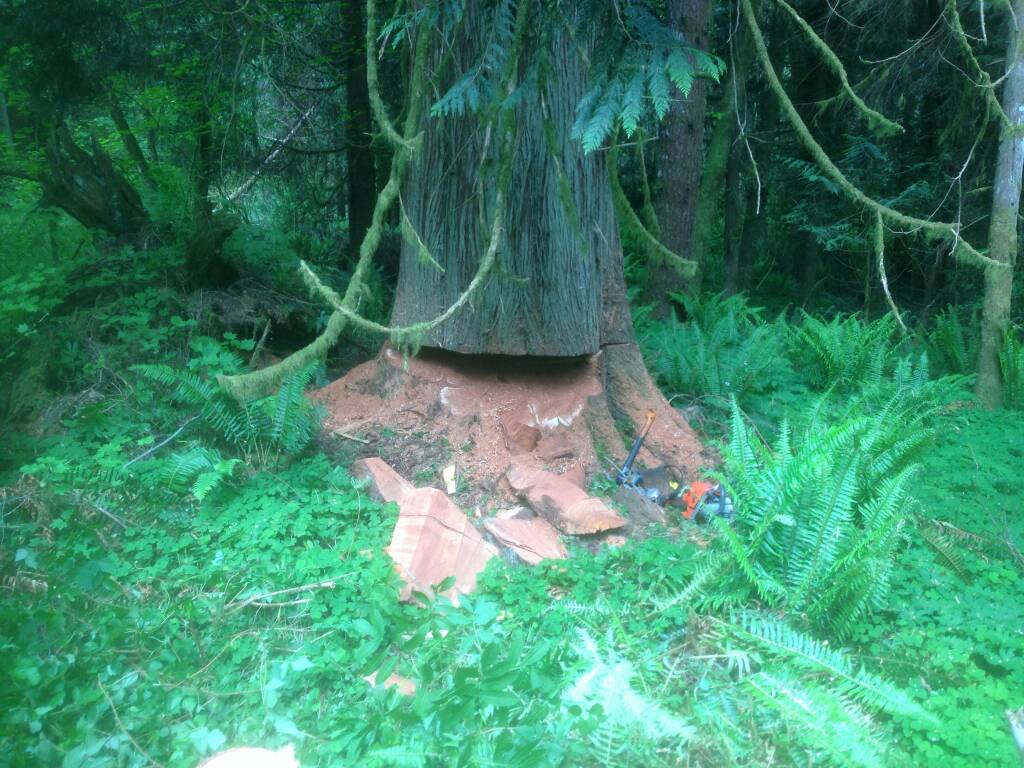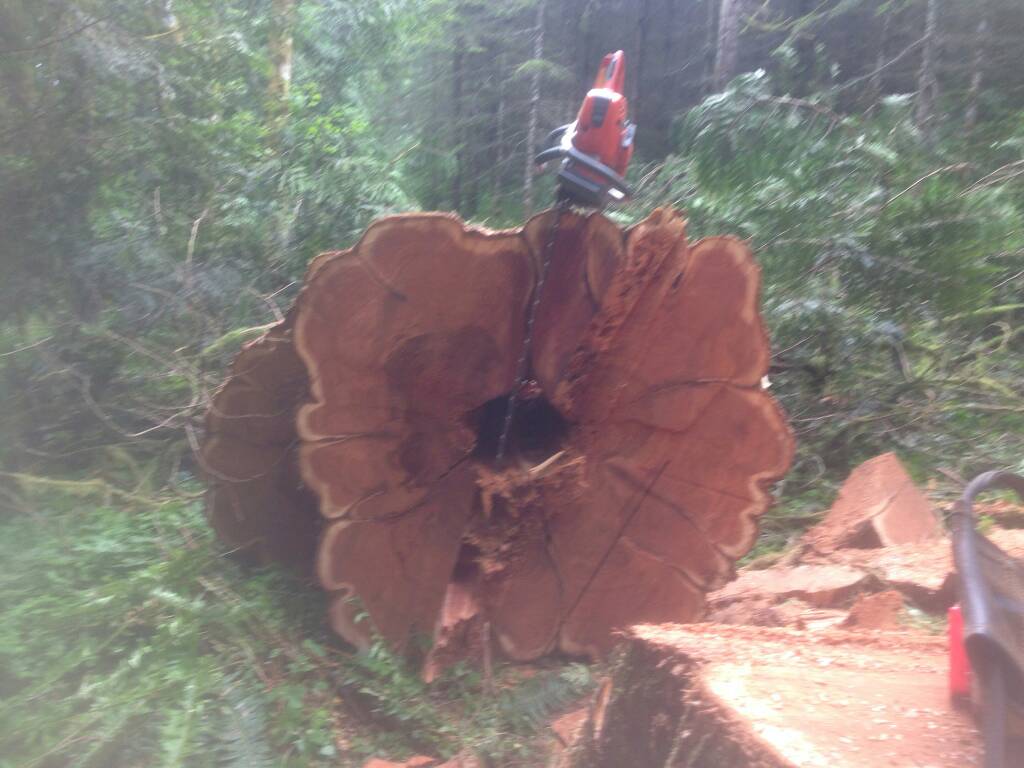You are using an out of date browser. It may not display this or other websites correctly.
You should upgrade or use an alternative browser.
You should upgrade or use an alternative browser.
What is wrong with this felling cut
- Thread starter JAW
- Start date

Help Support Arborist Forum:
This site may earn a commission from merchant affiliate
links, including eBay, Amazon, and others.
fireman33
ArboristSite Member
The "open face" shouldn't be 60% it should be more like 30 to 40%...the back cut should be parallel to the ground on that picture not on an angle. If you leave more wood for the back cut it gives you the opportunity to insert a wedge if needed.
fireman33
ArboristSite Member
Also the back cut should not meet the corner of cut 2 and 3...you absolutely need to leave hinge wood so you can actually direct the tree where you want it to fall...no hinge wood = free fall...watch out...hinge should be around 10% of diameter
In theory, your backcut should be higher than the apex of your notch to prevent the butt of the tree from sliding back on the stump.
The backcut should be parallel to the ground so if you were to wedge it the wedging force rotates the tree (vertically, not rotating the tree on the stump) at the hinge rather than putting lateral force against the hinge.
I have better success getting my notch cuts to line up when I make the top cut first.
When falling a full tree, the notch should be about 30% of the width of the tree. However, when I'm falling a peg, especially a short fat one, I'll make a much deeper notch 50-60%, This moves the hinge back in relation to the centre of mass and makes it easier to fall. If there is a risk of it falling backwards, put a rope in it.
The backcut should be parallel to the ground so if you were to wedge it the wedging force rotates the tree (vertically, not rotating the tree on the stump) at the hinge rather than putting lateral force against the hinge.
I have better success getting my notch cuts to line up when I make the top cut first.
When falling a full tree, the notch should be about 30% of the width of the tree. However, when I'm falling a peg, especially a short fat one, I'll make a much deeper notch 50-60%, This moves the hinge back in relation to the centre of mass and makes it easier to fall. If there is a risk of it falling backwards, put a rope in it.
JRoland
ArboristSite Operative
Also by doing the cuts in the order and the way you drew, you risk having cut 3 end up below cut 1 which is not good when tree is wanting to go in direction of open face.
JAW
New Member
- Joined
- Dec 22, 2013
- Messages
- 4
- Reaction score
- 0
Thanks everyone for some great replies. For some clarification, I do leave a hinge, cut 3 is stopped when the tree starts to go.
Due to my newness felling and inability to cut straight lines/angles, I found doing it by the book like fireman33 first posted resulted in several trees dropping backwards. Right now I'm cutting a large tree line between two fields so there is no danger of hitting anything but myself. Using my cut shown above has resulted in all the trees dropping exactly towards the notch (I'm notching in the direction they want to fall).
So basically I was wanting to know what was unsafe or dangerous about felling using my method. I assume something is wrong since I can't find any felling guides that shows doing it my way.
Due to my newness felling and inability to cut straight lines/angles, I found doing it by the book like fireman33 first posted resulted in several trees dropping backwards. Right now I'm cutting a large tree line between two fields so there is no danger of hitting anything but myself. Using my cut shown above has resulted in all the trees dropping exactly towards the notch (I'm notching in the direction they want to fall).
So basically I was wanting to know what was unsafe or dangerous about felling using my method. I assume something is wrong since I can't find any felling guides that shows doing it my way.
You won't find any good guidelines showing your method because it is not a good safe method. I won't reiterate what was said above because well, it's good advice and a waist of my tim to repeat it. The trees that fell in the undesired direction when you used the proper cut were likely leaning if a different direction than you desired. You can follow the recommended method and still have a tree fall the wrong way. This can happen if your trying to go against the lean, make you face cuts too deep or the wind pushes it backwards. The whole premise of proper hinge wood and the horizontal back cut is to control the tree during falling an prevent kickback. If wedging on a slipped back cut you induce a shear force on the hinge and run a higher risk of the hinge failing before the tree falls safely.Thanks everyone for some great replies. For some clarification, I do leave a hinge, cut 3 is stopped when the tree starts to go.
Due to my newness felling and inability to cut straight lines/angles, I found doing it by the book like fireman33 first posted resulted in several trees dropping backwards. Right now I'm cutting a large tree line between two fields so there is no danger of hitting anything but myself. Using my cut shown above has resulted in all the trees dropping exactly towards the notch (I'm notching in the direction they want to fall).
So basically I was wanting to know what was unsafe or dangerous about felling using my method. I assume something is wrong since I can't find any felling guides that shows doing it my way.
JAW
New Member
- Joined
- Dec 22, 2013
- Messages
- 4
- Reaction score
- 0
Thanks Marshy, from what you wrote (and BC Westcoast) I'm understanding that my angled back cut #3 is unsafe because it doesn't allow me to use a wedge the appropriate way-- puts wrong force on hinge.
So what is the big problem with the 60% open face cut (rather than 30%). Is it that a big wind gust or weakened tree causes an unexpected fall?
So what is the big problem with the 60% open face cut (rather than 30%). Is it that a big wind gust or weakened tree causes an unexpected fall?
It seems to me that you have moved the centre of gravity to far back with the
60% deep face cut hinge needs to be more forward and wedged until it leans toward
desired fall direction
60% deep face cut hinge needs to be more forward and wedged until it leans toward
desired fall direction
Nish
ArboristSite Lurker
If you've done it by the book to ill effect, you're probably expecting to0 much of the felling cuts. If the tree has back lean felling cuts alone aren't likely to make it tip forward, no matter how well they are crafted. Think of your felling cuts as directing the tree to fall a little to the right or a little to the left--after other forces (gravity, wind, wedges, ropes, jacks, heavy equipment) have already committed the tree to fall forward.
I only see disadvantage in cutting 3 at an such angle--it just makes it a harder cut, and harder to line up with your other cuts. You can stay an inch above the meeting points of 2 and 3 if there's reason to fear the butt jumping back on you at the end of the fall.
The deep face cut is helpful in some circumstances, but it's dangerous in others. The danger is exactly what you say it is.
I only see disadvantage in cutting 3 at an such angle--it just makes it a harder cut, and harder to line up with your other cuts. You can stay an inch above the meeting points of 2 and 3 if there's reason to fear the butt jumping back on you at the end of the fall.
The deep face cut is helpful in some circumstances, but it's dangerous in others. The danger is exactly what you say it is.
Trx250r180
Saw polisher
You need to read that tree better ,it is leaning 180 degrees of that huge face to start with ,its gonna go over backwards and smash your saw after you pinch it in the farmer back cut .Tell me why this is not a good felling method, assuming tree is wanting to go in the direction of the open face. Open face is approximately 60% of the way through the tree.
View attachment 448668
The width of the notch 60* vs 30* isn't as big a problem. With the smaller cut, when the tree goes over, it will break the hinge easier. This may or may not be advantageous to you depending on the situation. What is the problem with the notch you drew was the depth, how far it went into the tree.
Here is some good information for you. It is the standard to which Certified Fallers in BC must adhere to. In BC, commercially, you can't fall any tree over 8" diameter unless you are certified or using arborist techniques (roped, or climbed).
http://www.worksafebc.com/publicati.../assets/pdf/bc_faller_training_standard_1.pdf
http://www.worksafebc.com/publicati.../assets/pdf/bc_faller_training_standard_2.pdf
Here is some good information for you. It is the standard to which Certified Fallers in BC must adhere to. In BC, commercially, you can't fall any tree over 8" diameter unless you are certified or using arborist techniques (roped, or climbed).
http://www.worksafebc.com/publicati.../assets/pdf/bc_faller_training_standard_1.pdf
http://www.worksafebc.com/publicati.../assets/pdf/bc_faller_training_standard_2.pdf
Skeans
Addicted to ArboristSite



Back cut on the cedar wasn't perfectly even but had a slight step on it.
Sent from my SAMSUNG-SM-G890A using Tapatalk
zwoehr
ArboristSite Operative
Thanks for posting the links. After you get past the safety boilerplate they have a lot of good information about different falling cuts. I haven't seen anything explaining the differences between them and where to best use them before.The width of the notch 60* vs 30* isn't as big a problem. With the smaller cut, when the tree goes over, it will break the hinge easier. This may or may not be advantageous to you depending on the situation. What is the problem with the notch you drew was the depth, how far it went into the tree.
Here is some good information for you. It is the standard to which Certified Fallers in BC must adhere to. In BC, commercially, you can't fall any tree over 8" diameter unless you are certified or using arborist techniques (roped, or climbed).
http://www.worksafebc.com/publicati.../assets/pdf/bc_faller_training_standard_1.pdf
http://www.worksafebc.com/publicati.../assets/pdf/bc_faller_training_standard_2.pdf
I assume you meaning the difference between a regular notch, wide notch and humbolt notch.
There is lots of information out there about the technical differences. You have to be careful when you read about falling notches in BC. They require the humbolt to be used all the time. There are two reasons, the technical - prevents sliding back on the stump, the other which isn't discussed much is financial. In BC, virtually all the timber is owned by the government and the cutting rights licenced to the timber companies. The government gets a fee (called stumpage) from the volume of timber harvested. The stumpage rate is a complex calculation, one of the factors being average tree volume based on a 30cm (1 ft) high stump. If a regular notch was used, then the notch would be coming out of the butt log and not the stump, like you would get if you used a humbolt. This is considered a waste and the companies are fined for it.
I remember when I was in school, that if you were to square up a log when a regular notch was used, you would lose 1-2% of the volume of the log. That was a long time ago, my memory could be failing.
There is lots of information out there about the technical differences. You have to be careful when you read about falling notches in BC. They require the humbolt to be used all the time. There are two reasons, the technical - prevents sliding back on the stump, the other which isn't discussed much is financial. In BC, virtually all the timber is owned by the government and the cutting rights licenced to the timber companies. The government gets a fee (called stumpage) from the volume of timber harvested. The stumpage rate is a complex calculation, one of the factors being average tree volume based on a 30cm (1 ft) high stump. If a regular notch was used, then the notch would be coming out of the butt log and not the stump, like you would get if you used a humbolt. This is considered a waste and the companies are fined for it.
I remember when I was in school, that if you were to square up a log when a regular notch was used, you would lose 1-2% of the volume of the log. That was a long time ago, my memory could be failing.
Works good for timber that grows on hills. Just makes for taller stumps when your on flat land. Good points none the less.I assume you meaning the difference between a regular notch, wide notch and humbolt notch.
There is lots of information out there about the technical differences. You have to be careful when you read about falling notches in BC. They require the humbolt to be used all the time. There are two reasons, the technical - prevents sliding back on the stump, the other which isn't discussed much is financial. In BC, virtually all the timber is owned by the government and the cutting rights licenced to the timber companies. The government gets a fee (called stumpage) from the volume of timber harvested. The stumpage rate is a complex calculation, one of the factors being average tree volume based on a 30cm (1 ft) high stump. If a regular notch was used, then the notch would be coming out of the butt log and not the stump, like you would get if you used a humbolt. This is considered a waste and the companies are fined for it.
I remember when I was in school, that if you were to square up a log when a regular notch was used, you would lose 1-2% of the volume of the log. That was a long time ago, my memory could be failing.
SteveSr
Addicted to ArboristSite
I do volunteer trail construction and maintenance for several trail organizations. I have been through USFS and NWCG training every 3 years for the last two decades or so.Tell me why this is not a good felling method, assuming tree is wanting to go in the direction of the open face. Open face is approximately 60% of the way through the tree.
The safest techniques that I have found are the open face notch similar to the one you describe. The total open face angle should be greater than or equal to 90 degrees. If done properly this means that the trunk is still attached to the stump when the tree is on the ground. This prevents the tree from coming back at the sawyer.
Ideally the notch depth should only be 25% of the trunk diameter (diameter divided by 4). The hinge should be 10% of the diameter (diameter divided by 10... move the decimal point). This leaves 65% of the diameter for the horizontal back cut. If the tree is big enough this should allow room for wedges.
Once you have mastered this technique I would highly recommend that you learn bore cutting to construct the hinge. This adds another layer of safety against a barber chair in situations with excessive lean, head weight, or both. It also pretty much guarantees the ability to set wedges to prevent a sit back situation.
I wish I had some good pictures or videos to show this but I don't.
One important point to make is the difference between arborist practices and logging practices. Two similar yet totally different industries with totally separate priorities. As a result, some techniques cross over and many others dont.
most things have been addressed 1 more is,,, good felling saws are well balanced tools and will find chain bar 90° to ground if held in center of gravity,,,your 3 cuts require exceptional skills and aim 3 times and find operator working against saws design 3 times rather than the 1 for the face
Similar threads
- Replies
- 87
- Views
- 4K
- Replies
- 21
- Views
- 1K
Latest posts
-
Scrounging Firewood (and other stuff)
- Latest: sean donato
-
-
-
-
-
Want to Sell 3 Husqvarna projects for cheap. (Plus shipping)
- Latest: Maintenance supervisor
-
-




